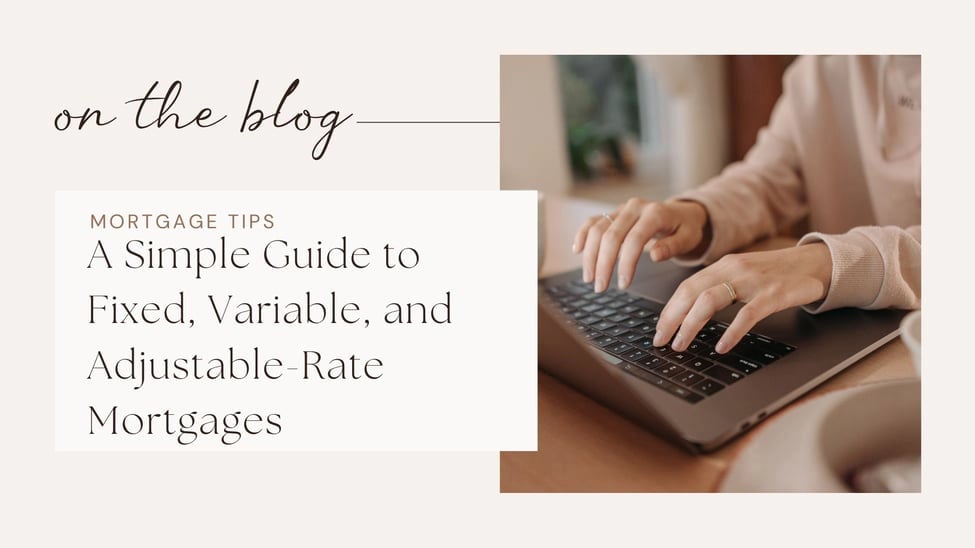With mortgage rates fluctuating over the past few years, choosing the right mortgage can feel overwhelming. Whether you're a first-time homebuyer or considering refinancing, understanding the differences between fixed-rate, variable-rate, and adjustable-rate mortgages (ARMs) can help you make a confident decision.
In this guide, we’ll break down each mortgage type, their benefits, and who they’re best suited for.
Fixed-Rate Mortgages: Stability and Predictability
A fixed-rate mortgage is one of the most popular choices among homebuyers. According to a 2024 survey by Mortgage Professionals Canada, 75% of borrowers chose a fixed-rate mortgage.
How It Works
With a fixed-rate mortgage, your interest rate remains the same for the entire term—whether it’s 1, 3, or 5 years. This means your monthly principal and interest payments won’t change, making budgeting easier.
Who Should Consider It?
✅ Homeowners who prefer stability and predictability
✅ Those planning to stay in their home for the full term
✅ Borrowers who expect interest rates to rise
Key Benefits
✔️ Consistent monthly payments—no surprises
✔️ Protection from rising interest rates
✔️ Peace of mind for long-term financial planning
Things to Consider
❌ Higher starting rates than variable or adjustable options
❌ Less flexibility if interest rates drop during your term
❌ Potentially high prepayment penalties if you break the mortgage early
Variable-Rate Mortgages: Savings with Some Risk
A variable-rate mortgage (VRM) comes with an interest rate that fluctuates based on your lender’s prime rate, which is directly influenced by the Bank of Canada’s policy rate.
How It Works
- If interest rates drop, more of your payment goes toward the principal, helping you pay off your mortgage faster.
- If interest rates rise, more of your payment covers interest, reducing the portion going toward your principal.
Some variable-rate mortgages have fixed payments (where the interest-to-principal ratio changes), while others have adjustable payments (where the payment amount fluctuates).
Who Should Consider It?
✅ Homebuyers who believe interest rates may decrease
✅ Borrowers comfortable with some level of financial risk
✅ Those considering selling or refinancing before the term ends
Key Benefits
✔️ Historically lower rates than fixed-rate mortgages
✔️ Potential savings if rates decrease over time
✔️ Lower prepayment penalties if you break your mortgage early
Things to Consider
❌ Monthly payments could increase if rates rise
❌ Requires a higher risk tolerance
Adjustable-Rate Mortgages (ARMs): Flexibility with Fluctuating Payments
Not all Canadian lenders offer adjustable-rate mortgages (ARMs), but banks and some Mortgage Finance Companies do.
How It Works
Unlike a VRM, an ARM adjusts both your interest rate and your monthly payment whenever the lender’s prime rate changes—meaning your payments fluctuate immediately, typically within 30 days of a rate change.
Who Should Consider It?
✅ Borrowers looking for lower initial rates
✅ Homebuyers who can manage fluctuating payments
✅ Those considering selling or refinancing before their term ends
Key Benefits
✔️ Typically lower starting rates than fixed or variable mortgages
✔️ Opportunity for savings when rates are low
✔️ Predictable prepayment penalties
Things to Consider
❌ Payments can increase significantly if interest rates rise
❌ Harder to budget due to fluctuating monthly costs
Which Mortgage Type is Right for You?
Choosing between a fixed, variable, or adjustable-rate mortgage depends on your financial goals, risk tolerance, and long-term plans.
✔️ If you want stability and predictable payments, a fixed-rate mortgage is the safest option.
✔️ If you’re comfortable with some risk and want the opportunity to save, a variable-rate mortgage might be a better fit.
✔️ If you’re looking for lower initial payments and are okay with payment fluctuations, an adjustable-rate mortgage could work for you.

